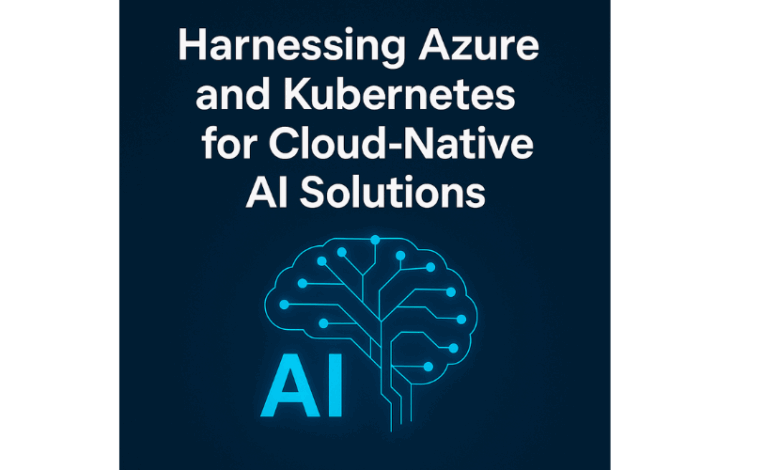
Introduction
In recent years, cloud-native applications have become the industry standard, enabling companies to harness unprecedented agility, scalability, and flexibility with technology. By merging cloud-native approaches with Artificial Intelligence (AI), businesses can address complex challenges, innovate rapidly, and derive valuable insights. Azure and Kubernetes are two cornerstone technologies leading this paradigm shift. Azure, with its versatile cloud platform, and Kubernetes, the gold standard for container orchestration, combine forces to offer a robust infrastructure for cloud-native AI solutions. This blog explores how Azure and Kubernetes power AI solutions, detailing their integration and benefits for businesses.
Deep Dive into Azure and Kubernetes for Cloud-Native AI
Defining Cloud-Native AI
What is Cloud-Native AI?
Cloud-native AI refers to AI solutions designed and built to utilize cloud environments fully. Instead of simply transferring existing AI applications to the cloud, cloud-native AI applications embrace microservices, containerization, automation, and orchestration to provide the highest degree of scalability, availability, and agility. In essence, the cloud-native AI approach involves re-architecting and developing AI applications to capitalize on cloud-native capabilities from the ground up, yielding highly resilient, manageable, and flexible AI deployments.
The Importance of Cloud-Native AI
Cloud-native AI is the future for AI deployments. Traditional on-premises infrastructure cannot always match the performance or flexibility provided by cloud environments. AI solutions, by their nature, are complex and often require significant computational resources, especially during model training. Cloud-native infrastructure provides a seamless environment to handle such demands, giving you a distinct competitive edge.
Azure’s Role in Cloud-Native AI
Azure, Microsoft’s comprehensive cloud computing platform, has become the go-to destination for AI developers and enterprises. Azure offers an extensive range of pre-built AI services, cutting-edge machine learning tools, and data management features. It also features Azure Machine Learning, a fully managed, end-to-end machine learning platform allowing easy creation, training, deployment, and management of AI models with minimal effort. Azure removes many complexities and simplifies AI workloads with a range of integrations.
Azure’s Key Features for AI
Azure Machine Learning: A complete machine learning platform that provides tools for model development, training, and deployment.
Azure Cognitive Services: A suite of APIs providing vision, speech, language, and decision-making capabilities to accelerate intelligent feature integration into applications.
Azure Databricks: A collaborative environment for big data analytics and AI applications.
Azure’s Integration Capabilities
Azure’s real strength lies in its ability to integrate seamlessly with existing business applications. It connects your AI workloads with your existing applications, allowing businesses to innovate faster without rebuilding existing applications from scratch. Whether AI integration is needed into CRM systems or existing business processes need automation through intelligent workflows, Azure bridges the gap and connects different technology stacks together, driving better productivity and faster time-to-market.
Kubernetes and AI: The Power Duo
Kubernetes for AI Workloads
Kubernetes plays a critical role in cloud-native AI development. Kubernetes is an open-source container orchestration tool for automating deployment, scaling, and management of containerized applications. Kubernetes provides a scalable container runtime environment and supports all container engines, including Docker. Kubernetes empowers organizations to manage and automate complex AI applications. Kubernetes brings a much-needed operational consistency to AI teams for AI workloads, ensuring they run consistently and reliably across development, staging, and production environments.
Benefits of Kubernetes for AI
The Kubernetes orchestration system can orchestrate AI models as microservices within containers, providing benefits that enhance the efficiency and effectiveness of AI operations, including:
Scalability: Kubernetes can automatically scale AI workloads based on demand, ensuring optimal use of resources.
Resilience: Containers and workloads can automatically recover in case of failure, ensuring high availability.
Resource Efficiency: Kubernetes optimizes resource allocation, leading to significant cost savings on hardware and cloud resources.
Portability: Kubernetes’ standardized environment allows AI workloads to run consistently across on-premises, cloud, and hybrid deployments.
Deploying AI Applications with Azure Kubernetes Service (AKS)
Azure Kubernetes Service (AKS) Overview
Azure Kubernetes Service (AKS) is Azure’s managed Kubernetes service, allowing businesses to easily deploy and manage containerized applications. AKS is built on Kubernetes and provides an easy-to-use platform for deploying, managing, and scaling containerized applications in Azure. AKS allows you to deploy and run containerized applications without the complexities of managing Kubernetes. This blog post will discuss deploying an AI model on Azure Kubernetes Service (AKS). It will show step-by-step how to containerize an AI application for Kubernetes, followed by instructions for using AKS to run the application on a cluster.
Step-by-Step AI Deployment on AKS
The following are the steps required to deploy AI models to Kubernetes:
Prepare your AI model: Containerize the AI application using Docker. This involves creating a Dockerfile that defines the environment needed to run your AI application in a container.
Create an AKS cluster: Create an AKS cluster via Azure Portal or Azure CLI. This step involves setting up the cluster according to your specific requirements.
Deploy Containers to AKS: With Kubernetes manifests (YAML files), define how your AI application runs on AKS, including resource requests, limits, and environment variables.
Expose your Application: Use Kubernetes services or Azure load balancers to expose your AI application to the public or internally for use.
Monitor and Optimize: Use Azure Monitor and other monitoring tools to monitor application performance and gather insights for ongoing improvements.





